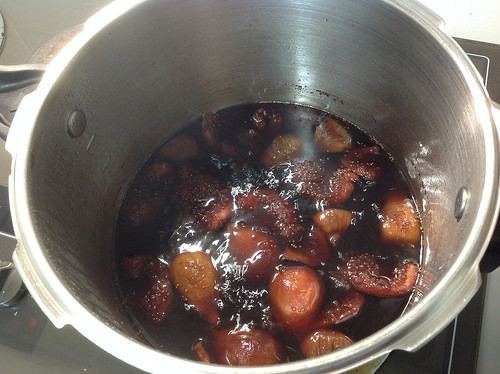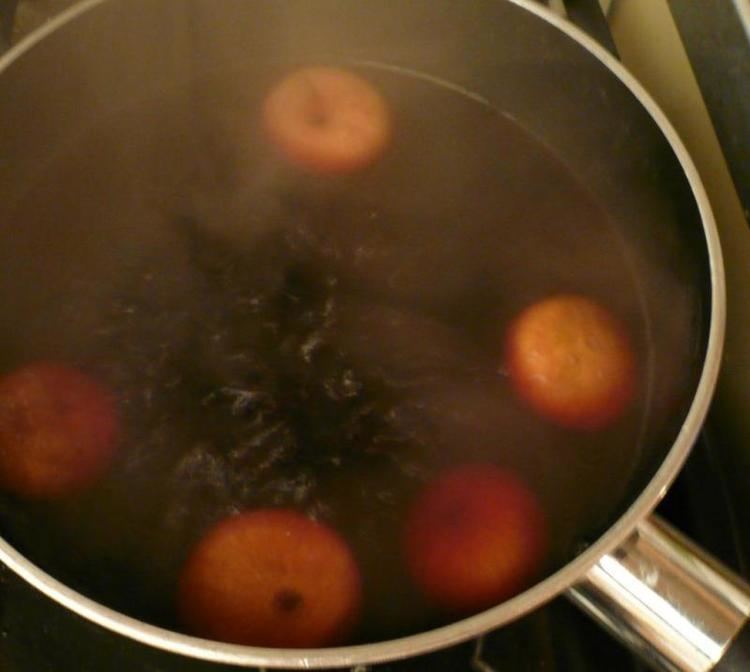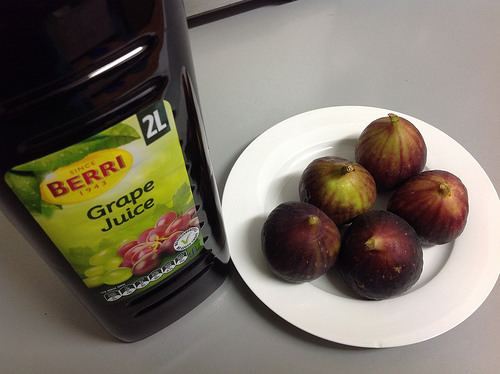 | ||
Similar Garum, Moretum, Posca, Grape syrup, Vino cotto | ||
Defrutum
Defrutum, carenum, and sapa were reductions of must used in Ancient Roman cuisine. In Ancient Greek cuisine, they were referred to as both siraion (Greek: σίραιον ) and epsima (Greek: έψημα). They were made by boiling down grape juice or must (freshly squeezed grapes) in large kettles until it had been reduced to two-thirds the original volume, carenum; half the original volume, defrutum; and one-third, sapa. The main culinary use of defrutum was to help preserve and sweeten wine, but it was also added to fruit and meat dishes as a sweetening and souring agent and even given to food animals such as suckling pig and duck to improve the taste of their flesh. Defrutum was mixed with garum to make the popular condiment oenogarum and as such was one of Rome's most popular condiments. Quince and melon were preserved in defrutum and honey through the winter, and some Roman women used defrutum or sapa as a cosmetic. Defrutum was often used as a food preservative in provisions for Roman troops.
Contents

Defrutum en la villa romana de la olmeda kuanum
Greco-Roman use

One of the earliest attestations comes from the fifth century BC physician Hippocrates, who refers to epsima, the Greek name for the condiment. The fifth-century BC Athenian playwright Aristophanes also makes a reference to it.

Defrutum is mentioned in almost all Roman books dealing with cooking or household management. Pliny the Elder recommended that defrutum only be boiled at the time of the new moon, while Cato the Censor suggested that only the sweetest possible must should be used.

Bronze, copper, and lead kettles were known to have been used. Geochemist Jerome Nriagu published an article in the New England Journal of Medicine in 1983 hypothesizing that defrutum and sapa may have contained enough leached lead acetate to be of danger to those who consumed it regularly.
A 2009 History Channel documentary produced a batch of historically accurate defrutum in lead-lined vessels and tested the liquid, finding a lead level of 29,000 ppb, a staggering 2,900 times higher than the current US drinking water standards of 10 ppb. These levels are easily high enough to cause either acute lead toxicity if consumed at once in large amounts or chronic lead poisoning when consumed in smaller quantities over a longer period of time (as defrutum was typically used).
However, the use of leaden cookware, though popular, was not the general standard, and copper cookware was used far more generally and no indication exists as to how often sapa was added or in what quantity. John Scarborough, a pharmacologist and classicist, criticized the conclusions drawn by Nriagu's book as "so full of false evidence, miscitations, typographical errors, and a blatant flippancy regarding primary sources that the reader cannot trust the basic arguments."
Modern-day usage
Sapa or vincotto is commonly used in Italy, especially in Emilia Romagna, Marche, Calabria, and Sardinia, where it is considered among the traditional flavors.
In Sardinia, the saba from grape must, from the fruit of prickly pear or more rarely from arbutus, is used in the preparation of traditional sweets and cakes.
The ancient Greek name epsima (Cypriot Greek: έψημα) is still used to refer to the condiment, which is still made in Cyprus.
In Greece, it is called petimezi and in Turkey pekmez.
